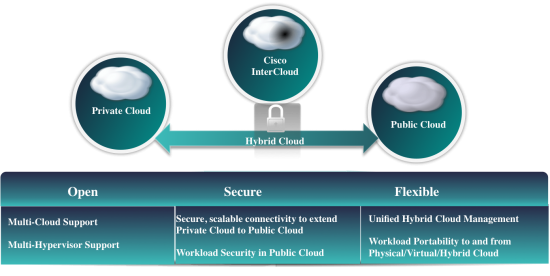In my last blog, “Has Hybrid Cloud Arrived? Part 1: And How Will it Shape the Role of IT Going Forward?” we looked at the business drivers of a hybrid cloud and previewed the key requirements. In this blog, we will look at Cisco InterCloud – a hybrid cloud solution, we announced this week at Cisco Live! Milan, to address the hybrid cloud needs for enterprise and service provider customers.
Business leaders today are heavily growth-oriented and are looking at new ways of deploying applications to obtain greater agility. That is where we see hybrid cloud becoming mainstream as it frees businesses to run applications on-demand and where it’s most cost-effective. Cisco InterCloud was announced to address this opportunity and facilitate optimal hybrid cloud deployments.

Cisco InterCloud comes with unique capabilities that enable enterprises to connect their private cloud to heterogeneous public clouds. It creates the notion of a single scalable hybrid cloud for all physical, virtual and cloud workloads – an infinite datacenter where the public cloud is treated as a virtual extension of the data center. Cisco InterCloud is designed with these tenets:
Open: Customers are excited about Cisco InterCloud, as it is an open solution that gives customers the freedom to choose hypervisor on private cloud and select their public cloud from a rich ecosystem of cloud providers. Service providers like InterCloud as it is open API based, integrates with multiple cloud platforms, e.g., CloudStack, vCloud, and OpenStack and enables them to rapidly offer a hybrid cloud solution. It reduces the effort to onboard enterprise customers. Cisco InterCloud thus provides a multi-cloud, multi-hypervisor cloud experience.
Secure: Another key factor in hybrid cloud adoption is the need to address the security and compliance concerns of public cloud deployment. Cisco InterCloud provides end-to-end secure connectivity by encrypting traffic between the enterprise private cloud and the service provider cloud. It also ensures workload security by encrypting all data-in-motion within shared multi-tenant public cloud. Additionally, customers can also deploy network services such as zone based virtual firewall and edge firewall for further workload security within public cloud.
Flexible: Customers demand bi-directional workload portability across private and public clouds. With Cisco InterCloud, customers not only can provision workloads from a self-service portal, but also with a click, migrate workloads to the public cloud and back. All of this activity happens behind the scenes as InterCloud converts workloads to the right VM format, such as VMware VMDK to AWS AMI, or to CloudStack format for providers such as BT. It makes workload portability easier as applications don’t need to be re-architected as IP addresses are retained upon migration and enterprise VLANs are extended into the cloud.
I believe that lines of business and developers are leading the journey to hybrid cloud adoption. IT has realized that it needs to shift away from its role as gatekeeper to instead being a partner to Lines of Business but IT faces certain challenges in doing so. IT has to deal with the overhead of integrating with each cloud provider and find ways to do in a secure manner. Cisco InterCloud enables IT to act as a cloud broker on behalf of lines of business. Cisco InterCloud provides unified hybrid cloud management through a built-in IT Admin portal and an extensible northbound API layer. It also allows IT to enforce consistent network security, L4-7 services and workload policies throughout the hybrid cloud.
This week’s Cisco InterCloud announcement demonstrates our continued commitment to customers. We envision a future where customers have an array of cloud options and can pick the ‘best fit’ based on workload needs, performance, cost, and location requirements. We are going into beta next quarter and have announced general availability soon afterwards. As 2014 dawns, we see a shift towards mainstream hybrid cloud adoption — hybrid cloud is finally here for real.
Well, hybrid cloud is not that rare nowadays. But it does seem that Cisco can make it more viable and attractive and they could even dominate the hybrid cloud market as it is.
Hybrid is already another overused term in the overused cloud space. This blog fairly defines hybrid, but the end user/IT governance or unified self service catalog is what will crown the real winner in the hybrid cloud battle…who’s got the lead is the question?
hybrid / Multi-cloud should go beyond Compute, connectivity, collaboration capabilities. As industry Cloud leader Cisco Hybrid Cloud architecture should consider Enterprise Customer’s eco-system , integration with enterprise IT service operations and inter & intra cloud service, application and data inter-operability.
Hybrid cloud framework and architecture should enable Enterprise IT to build and operate :
– Platform and IT services to Enterprise’s partners and suppliers, Dealers. Transform Enterprise IT to Enterprise Ecosystem service provider.
– support Business applications – ERP, SCM, CRM and many more.
– Architecture capability should cover cloud service mgmt., capacity, inventory, performance and IT financial s and integration with – workflow, assurance and policy engine etc.